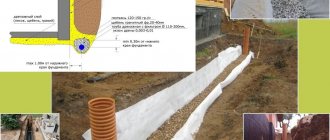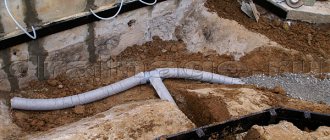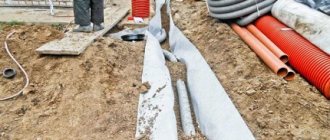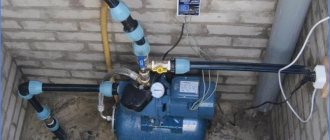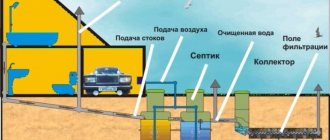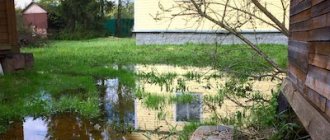Communications Editor 9054
There are practically no ideal plots of land. Problems arise with the slope of the terrain, land quality and groundwater. A real lucky person can be called the owner of a flat piece of land, in an area where there are rarely heavy rainfalls, there is no snow in winter, and groundwater does not rise above 3 meters. In this case, any worries are unnecessary, especially the drainage system. Everyone else, that is, the majority, should think about improving the site and do it, in order to save money, with their own hands.
Complete drainage is necessary if:
- clay predominates in the soil of the site;
- rain is not uncommon in this area;
- groundwater flows high;
- the basement periodically floods;
- low location of the site;
- the land is located on the slope of a hill or at its foot.
Why is clay a problem for summer residents?
Not many plants like to grow in clay soils. In most cases, this is the cause of growth retardation, lack of oxygen and nutrients.
The land is difficult to cultivate. It is quickly pressed into a dense layer that does not allow water to pass through.
Excess moisture destroys buildings. Promotes the spread of dampness, fungus, and an unpleasant musty odor. Therefore, the fight for dryness becomes an achievable and realistic goal.
Lawns are especially affected. They cannot be loosened and saturated with air, and underneath there is only a lump of plasticine that does not let anything through. Green grass quickly turns yellow and dies.
Construction of artificial reservoirs
If the size and geological features of the site allow, then one of the ways to drain the site can be considered the creation of an artificial pond. This can be done when the lowest and wettest place is located on the periphery of the site. And although this method is called drainage without drainage, surface drains here can be present in the form of ditches designed as decorative or “dry” streams.
Where does site drainage begin?
This event seems difficult only at first glance. In fact, you can do it yourself. To do this, you need to carefully think through and plan your actions, calculate materials, forces, and proceed confidently.
You need to have a system diagram. It will be useful not only for step-by-step work. Subsequently, you can always determine where the pipes run, the main connections and the well are located, the distance from the foundation and at what depth you need to look for the pipe. Over time, data is forgotten, so it would be useful to record everything on paper. You can make a plan schematically, but accurately express in numbers the depth, width, length, distance to the main objects.
Key points before starting work
The installed water removal system depends on a number of factors that directly affect:
- land area;
- on the cost of the project;
- on the scale of work;
- types of drains used.
Factors:
- soil complexity;
- the amount of precipitation of various types, including groundwater;
- financial position;
- degree of awareness.
Before you start designing, stock up on the necessary information:
- how to calculate precipitation;
- existing types of drainage;
- what type is suitable for the conditions of the site;
- combination possibilities for savings.
What is drainage like?
There are two schemes for installing a drainage system:
- deep; neutralizes high groundwater, preserves underground communications, basements, foundations, protects tree roots;
- superficial; is responsible for collecting water formed from precipitation; directs it into a drainage ditch or equipped well.
Ideally, the decision on the type of system should be made by a geologist. He conducts soil research, knows about the presence of underground flows and the main direction of water movement. Therefore, he can make an objective conclusion. But this is necessary when building a multi-storey building or an entire complex. An ordinary gardener is not going to disturb the layers of the earth. It will only drain water from its several acres of clay.
What you need to think about before starting work:
- when installing a deep system, you will have to dig up most of the site, so you should not rush to plant trees, shrubs and other perennial plants;
- It is better to combine laying the foundation of a house, bathhouse, outbuildings and drainage;
- It is important to identify places where water accumulates faster and stagnates more.
Features of clay soil
It may seem that it is worth first observing how an area with clay soil behaves, how much it floods and whether it is worth considering a drainage system. However, experts recommend doing drainage in such a site immediately after purchasing the site. The closer groundwater comes to the surface of the site, the more critical the arrangement of the drainage system is.
What are the characteristics of clay soil? Clay complicates construction work and is considered an inveterate enemy of both plants and foundations.
You can even determine clay soil by eye - if puddles collect in low places and remain for a long time, this means there is a large layer of clay on top that practically does not absorb water.
On such soil, water lingers for a long time without seeping in, which creates discomfort in the yard, which turns into impenetrable viscous sticky mud, and in the garden, which is constantly covered with a crust that cannot be loosened. Even the weed begins to wither, not to mention the cultivated plants. A lawn on such soil will always be dry, and if you organize constant watering, it will turn into a swamp with an unpleasant odor - the root system will quickly rot.
If the groundwater is not deep, the clay will be wet all year long, and vegetables and flowers will rot hopelessly. Buildings will also be unlucky - the waterproofing of the foundation will quickly break down.
However, all this is not a death sentence if you properly arrange the drainage system taking into account the characteristics of the soil. Life on a site with clay soil can be quite comfortable.
It may even be that drainage alone will not be enough and a stormwater system will be needed. This is not difficult to determine: make a hole in the area a little more than half a meter and fill it with five to seven buckets of water. If the water has not gone away within 24 hours, you will need to organize a stormwater system.
Tools and materials
All work is done with your own hands, but with the help of construction tools. Would need:
- wheelbarrow for bulk materials;
- bayonet and shovel shovels;
- building level;
- pipe saw;
- device for compacting earth.
Materials:
- pipes or plastic (concrete) products for the surface system;
- elements for installation of wells;
- fittings, corner connections, couplings;
- crushed stone of small or medium fraction;
- sand;
- geosynthetic material for insulation.
Preparation
Before choosing the type of drainage system, it is recommended to perform a geological study of the soil. Define:
- soil type;
- soil structure;
Structure of clay soil
- the main cause of high humidity levels.
Based on the results of the study, a selection of the type of drainage system is made.
A plan is drawn up with a clear indication of the location and depth of arrangement of drainage elements.
Surface drainage system
The best conditions are the natural slope of the site's topography. Then you have to put in less effort, and effective drainage is easier to achieve.
Open drainage is possible where there is a flat surface. For example, tiles have been laid. Along the perimeter of buildings, along the entire length of the site, along the paths of the garden and vegetable garden, along the edge of the lawn, playgrounds, plastic or concrete gutters are placed to form a directed flow of water.
Small wells receive water. From them, it is removed from the site through underground pipes. Water can be discharged into a natural reservoir, a large well, or a ditch. Water intake wells of several cubic meters are very useful for a strategic supply of technical water. Rainwater is useful for irrigation or household needs.
In surface construction, the underground part of the work is relatively small. It is much easier to maintain. She copes with her duties even in the cold season. The water, thawed even under snow and ice, gradually flows into wells. For the installation of drainage communications, many devices, special tiles, ready-made wells, and connections are produced.
How to determine the need for dehumidification
The owner of the site, who has owned it for a long time, knows the problem of the site without conducting an examination or geological survey - he observes flooding with sedimentary waters every time the snow melts or the rainy season begins. This happens when the soil is clayey and poorly allows water to penetrate deep into it, or the groundwater lies high and high water is added to it.
Another reason is that the site lies in a lowland and water flows from the neighboring slopes, but does not always quickly seep deeper. The proximity of a pond or swamp also has an effect.
If the plot has just been acquired, then you can only find out about the dangerous proximity to the groundwater surface in spring or autumn. But you can see the manifestations of swampiness in the area as follows:
- swollen and warped door frames;
- cracks are noticeable on the walls and corners;
- there is a smell of dampness in the rooms and premises;
- outside (on the north side or in the shade) there is mold on the base;
- the basement is damp or there is water in it;
- There are a lot of mosquitoes in the evening.
Deep system
This drainage immediately removes water from the surface. It resembles an extensive network of underground communications. A deep system is installed when it is necessary to remove a large amount of water, therefore the approach to its installation is more responsible.
- Think about where the excess moisture will go. There are several options:
- into a ditch running outside the site;
- into a natural body of water;
- into an artificially created small pond;
- into a well on the edge or outside the boundary.
- According to the developed scheme, long trenches are dug. Depth no more than 120 cm, width 40-50 cm. These are main canals. Each pipe must reach the final water inlet. Recommended diameter 110 mm. The main pipeline differs from the auxiliary pipeline in the depth of its location and the footage to the buildings. The lines are drawn from the building at a distance of no more than 1 m, from fences 0.5 m;
- The bottom of the trenches is lined with geotextiles and covered with a 20 cm layer of crushed stone;
- Next, a network of small drainage trenches is created. Their task is to collect water into a single stream that goes through the main pipes. The depth is from 100 cm to 120 cm, the width is 40 cm. The slope towards the main highway is 5 cm by 100 cm. With a smaller slope, the water will drain worse;
- After the formation of a unified network, it should be checked. To do this, I run a stream of water from a hose through all small trenches. After observation, it is possible to see problem areas. If drainage fails, larger pipe diameters or adding additional lines will help;
- After successful tests, the network is closed. The main main pipes are covered with crushed stone no less than 15 cm thick. They are covered with a layer of geotextile waiting on the walls of the trench. Then they wake up with a layer of sand and clayey soil;
- The entire network is wrapped in geotextiles. It will prevent silting and washing out of soil particles. Serves for decades and does not rot;
- Multiple entrances can be made from the surface. It is advisable to install filters to prevent contamination. Filters are also easy to make with your own hands. These can be small geotextile pillows filled with coconut fiber or pine sawdust.
It can be useful:
- the heavier the composition of the earth, the greater the number of trenches that need to be made;
- the depth of freezing of the ground should be taken into account;
- pipes should not pass under vehicle parking areas;
- It is important to wrap all connections, corners and joints in geotextiles; this material will preserve the pipe and eliminate the problems of clogging and stagnation of water.
In order not to damage the deep drainage and always know the location, you can fill the trenches with crushed stone and a layer of decorative granite up to the surface of the clay soil. Plant plants along the edges. You will get beautiful dry streams.
The operation of deep and surface drainage structures has been tested over years of practice. Correct installation with your own hands will eliminate the problems of excess water for many years. Maintenance consists of seasonal inspection. If filters are installed, replace them. In the timely pumping of water from sealed water intake wells.
The project is the basis for upcoming work
Drainage can be of different types, not only according to the materials used, but also the methods of installation: deep, surface laying. The first option is laid at a certain depth, using auxiliary mixtures, winding, and other materials used in construction. Option number two installs shallowly and has an open surface, which is protected by a grille. Particularly difficult areas use both types simultaneously; this approach allows you to increase the outflow of water and bring the indicators to the daily norm.
Laying drains in parking areas is highly undesirable. The soil becomes very compacted, and the flow of liquid stops. Avoid unnecessary spending!
Diagram of the drainage system on the site Carrying out earthworks, during the installation of deep drainage, the bottom of the trench must be properly loosened. Increases cross-country ability.
When drawing up a project, take a site plan, or sketch out the entire structure, including temporary buildings, on paper. Small areas will do without complex engineering calculations. Use a level to determine which direction the slope goes.
An important part of the project is to correctly direct the fluid flows.
Mark the preliminary location of the drainage on the diagram. Locate the main line. The main pipeline should be located from the highest point to the lowest. The missing slope is created artificially during earthworks; it is imperative to record the need for creation in the project.
Afterwards, a diagram of the drainage channels is made, and auxiliary branches are applied. Clay soils are very treacherous, the distance between channels is 10 meters, a highly branched network, can be compared to a Christmas tree paw.
The combined system assumes the presence of areas for rapid water collection on the surface.
For the manufacture of the main line, pipes with a diameter of 100-150 mm are used, auxiliary sections of the system - 50-63 mm.
An important question is where will the collected liquid be discharged? If there is no special channel nearby, it is necessary to build one, provide a sump, with subsequent use of water, a well with a drainage pump.
